Charles E W Bean, Diaries, AWM38 3DRL 606/274/1 - 1918 - 1941 - Part 14

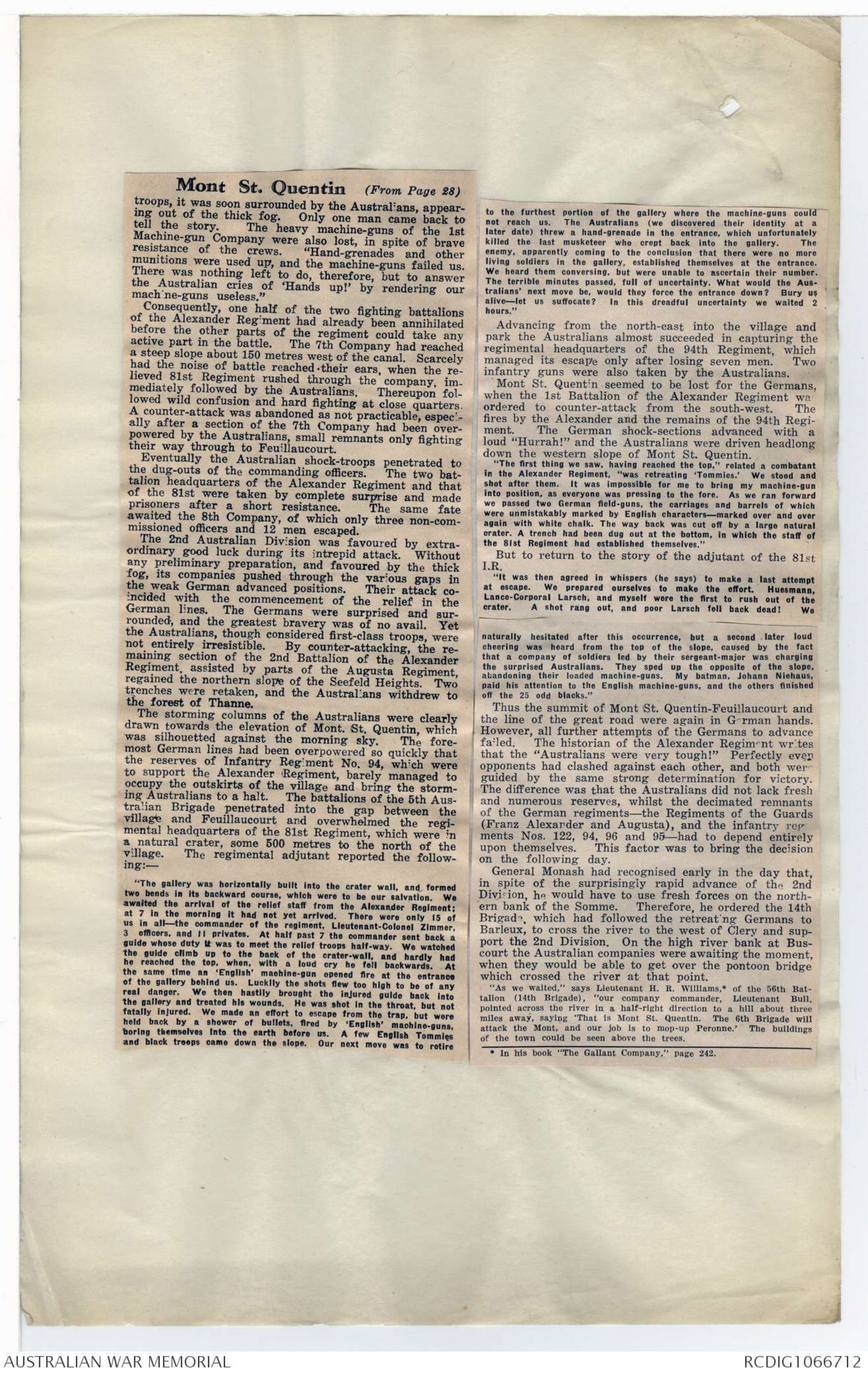
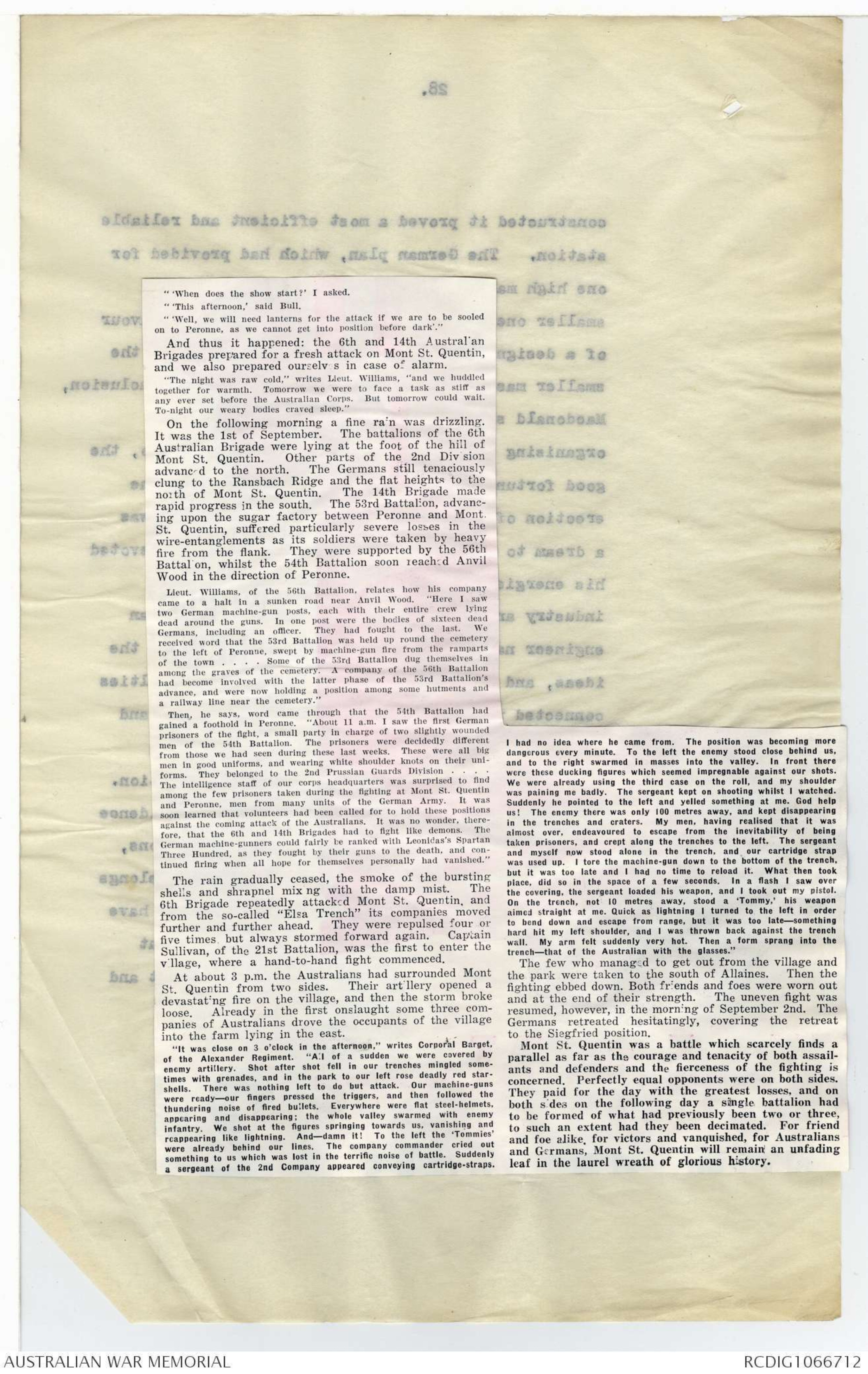

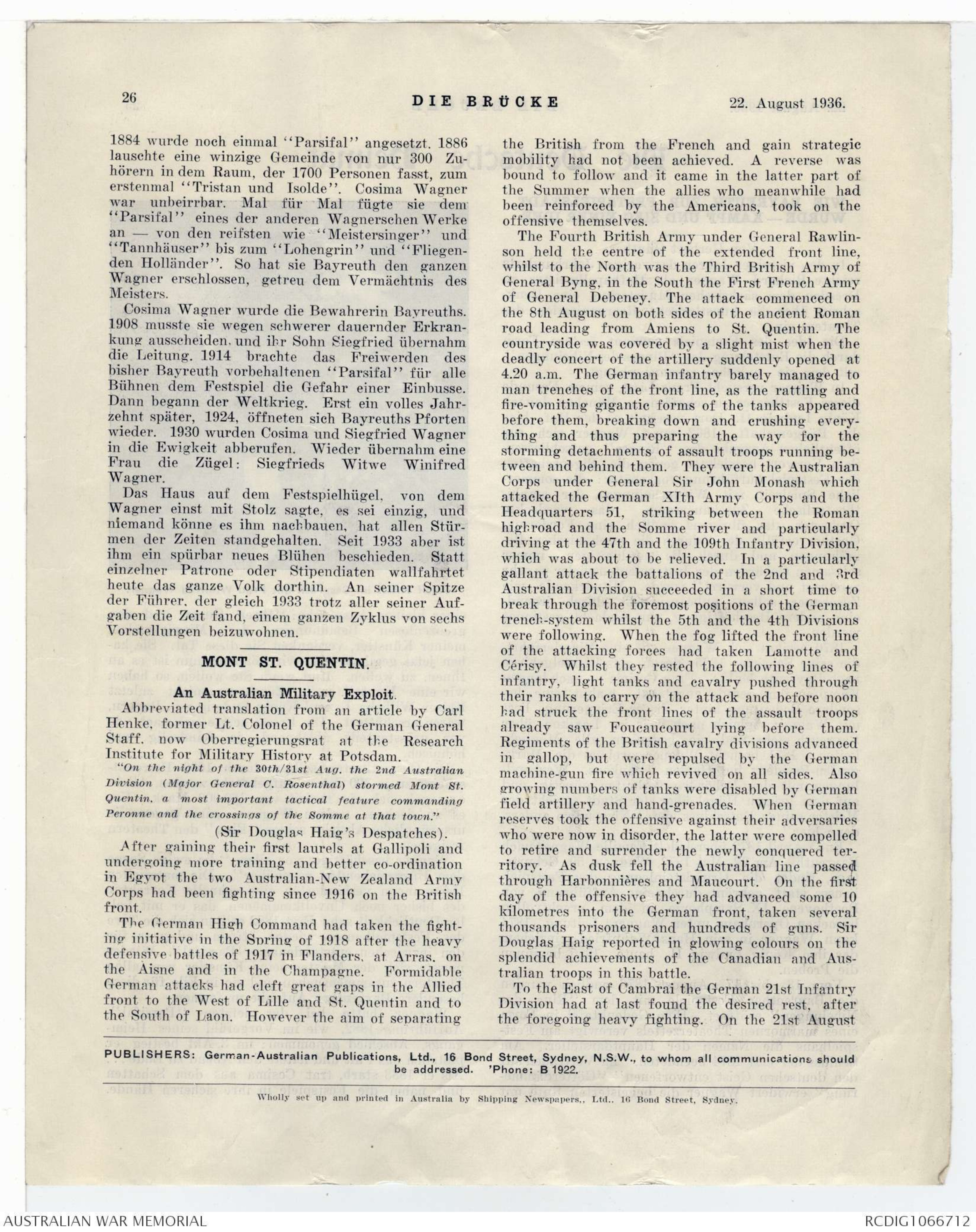
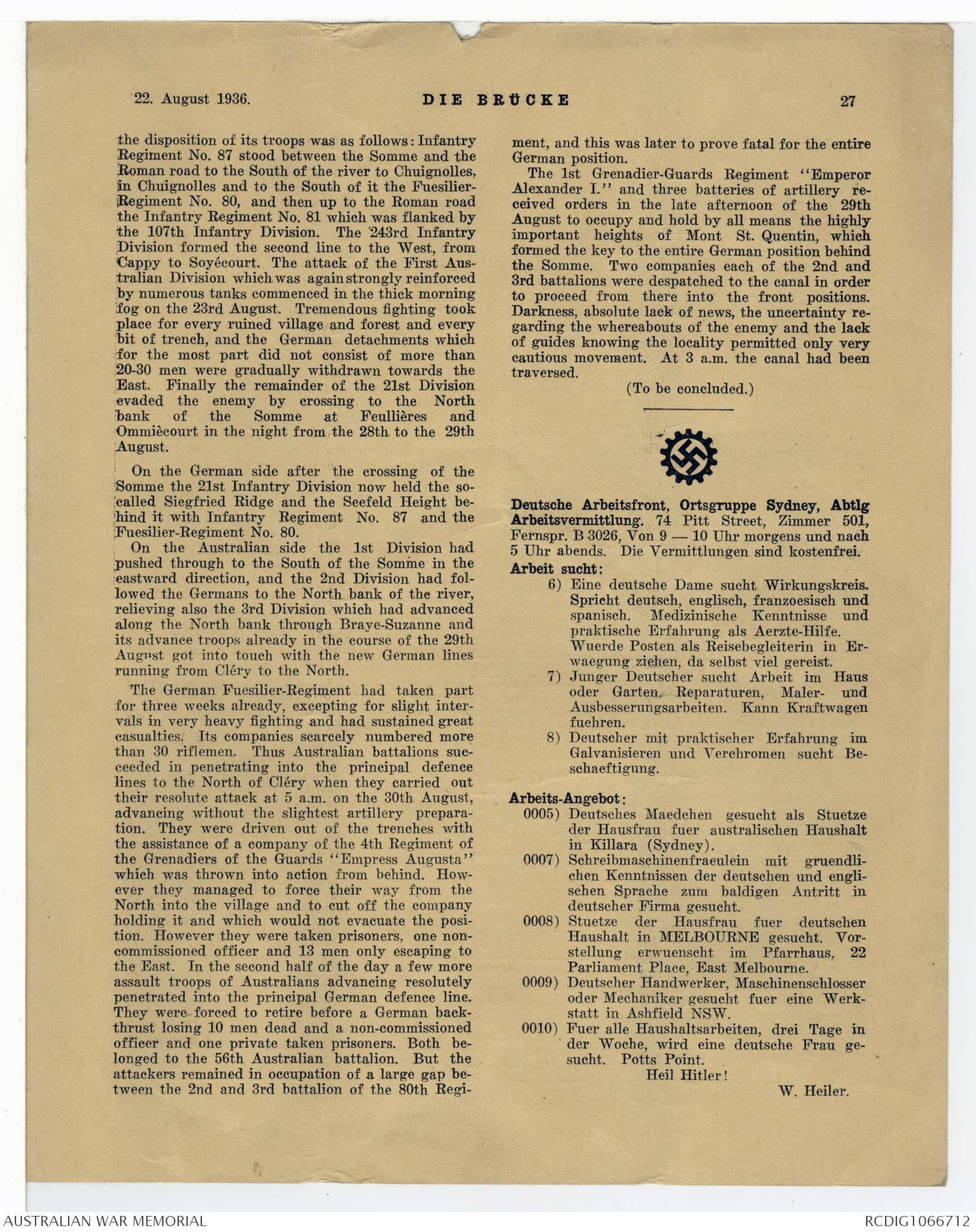

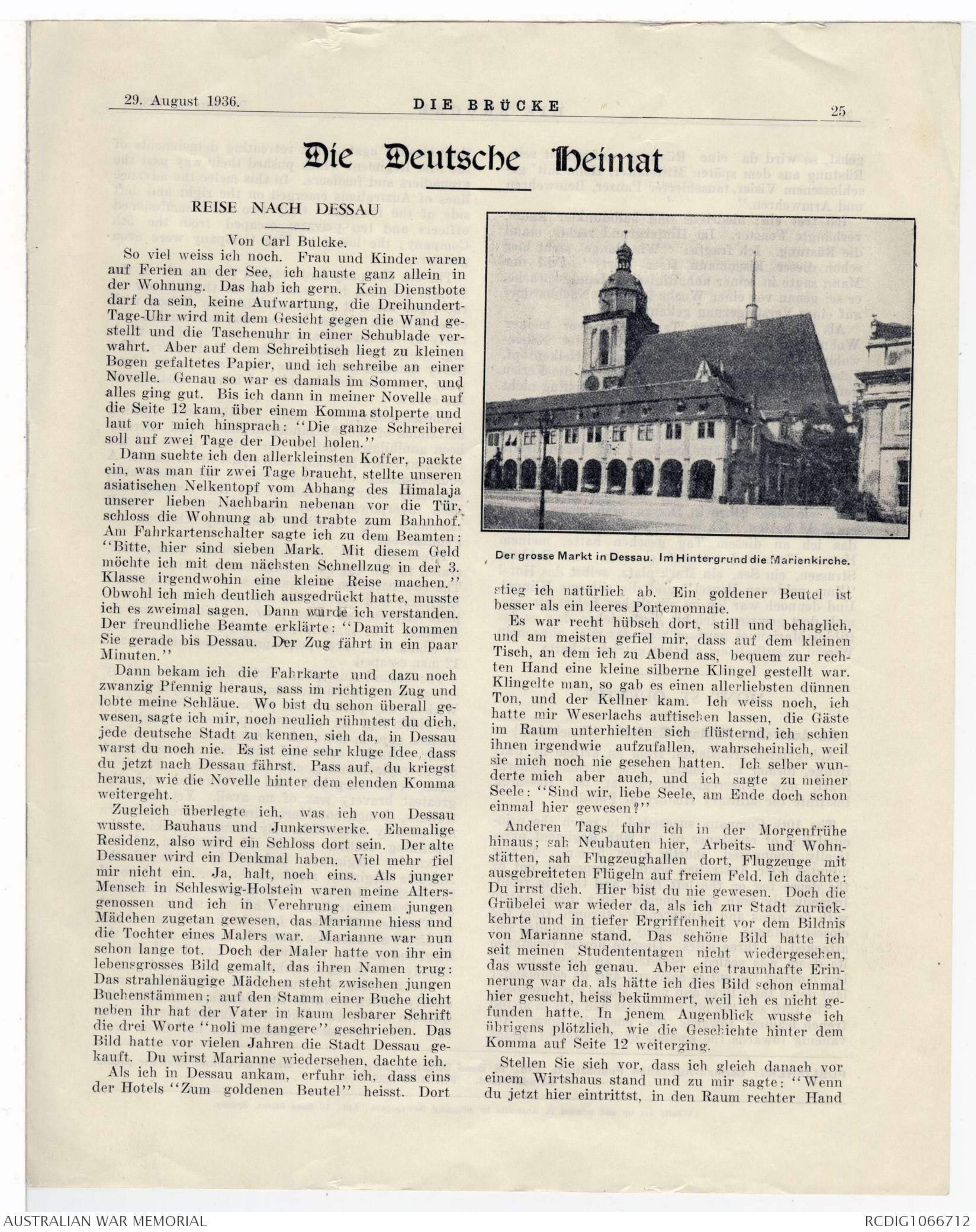
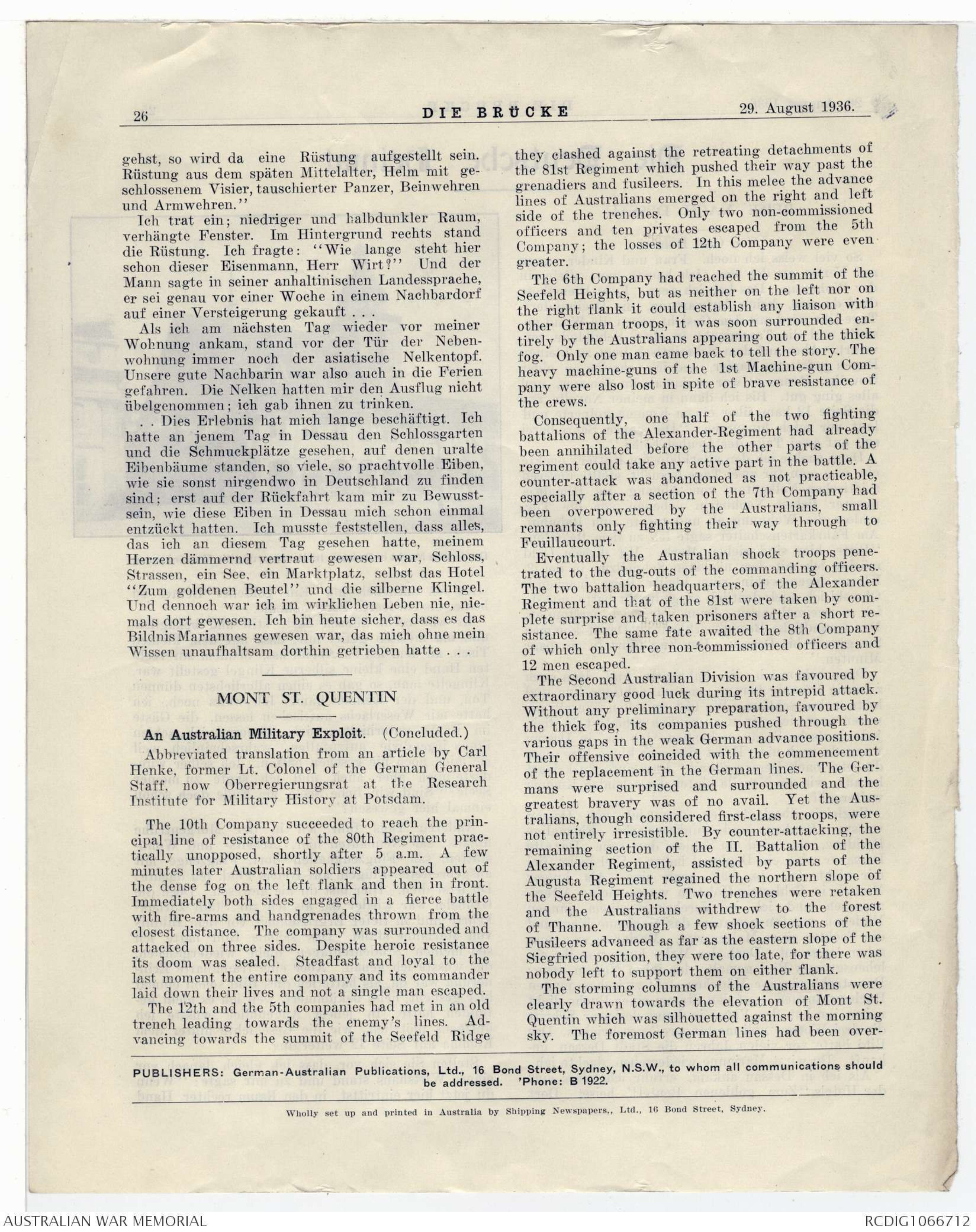

No 2, Copy
4
5
9
11
14
20
Vol X
Refer
to
Sth [[?]]
CHAPTER XIII.
TROPICAL MEDICINE. THE WORK OF THE
AUSTRALIAN ARMY MEDICAL CORPS.
Mont St. Quentin (From Page 28)
troops, it was soon surrounded by the Australians, appearing
out of the thick fog. Only one man came back to
tell the story. The heavy machine-guns of the 1st
Machine-gun Company were also lost, in spite of brave
resistance of the crews. "Hand-grenades and other
munitions were used up, and the machine-guns failed us.
There was nothing left do do, therefore, but to answer
the Australian cries of 'Hands up!' by rendering our
machine-guns useless."
Consequently, one half of the two fighting battalions
of the Alexander Regiment had already been annihilated
before the other parts of the regiment could take any
active part in the battle. The 7th Company had reached
a steep slope about 150 metres west of the canal. Scarcely
had the noise of battle reached their ears, when the relieved
81st Regiment rushed through the company, immediately
followed by the Australians. Thereupon followed
wild confusion and hard fighting at close quarters.
A counter-attack was abandoned as not practicable, especially
after a section of the 7th Company had been overpowered
by the Australians, small remnants only fighting
their way through to Feuillaucourt.
Eventually the Australian shock-troops penetrated to
the dug-outs of the commanding officers. The two battalion
headquarters of the Alexander Regiment and that
of the 81st were taken by complete surprise and made
prisoners after a short resistance. The same fate
awaited the 8th Company, of which only three non-commissioned
officers and 12 men escaped.
The 2nd Australian Division was favoured by extraordinary
good luck during its intrepid attack. Without
any preliminary preparation, and favoured by the thick
fog, its companies pushed through the various gaps in
the weak German advanced positions. Their attack coincided
with the commencement of the relief in the
German lines. The Germans were surprised and surrounded,
and the greatest bravery was of no avail. Yet
the Australians, though considered first-class troops, were
not entirely irresistible. By counter-attacking, the remaining
section of the 2nd Battalion of the Alexander
Regiment, assisted by parts of the Augusta Regiment,
regained the northern slope of the Seefeld Heights. Two
trenches were retaken, and the Australians withdrew to
the forest of Thanne.
The storming columns of the Australians were clearly
drawn towards the elevation of Mont. St. Quentin, which
was silhouetted against the morning sky. The foremost
German lines had been overpowered so quickly that
the reserves of Infantry Regiment No. 94, which were
to support the Alexander Regiment, barely managed to
occupy the outskirts of the village and bring the storming
Australians to a halt. The battalions of the 5th Australian
Brigade penetrated into the gap between the
village and Feuillaucourt and overwhelmed the regimental
headquarters of the 81st Regiment, which were in
a natural crater, some 500 metres to the north of the
village. The regimental adjutant reported the following:-
"The gallery was horizontally built into the crater wall, and formed
two bends is its backward course, which were to be our salvation. We
awaited the arrival of the relief from the Alexander Regiment;
at 7 in the morning it had not yet arrived. There were only 15 of
us in all-the commander of the regiment, Lieutenant-Colonel Zimmer,
3 officers, and 11 privates. At half past 7 the commander sent back a
guide whose duty it was to meet the relief troops half-way. We watched
the guide climb up to the back of the crater-wall, and hardly had
he reached the top, when, with a loud cry he fell backwards. At
the same time an 'English' machine-gun opened fire at the entrance
at the gallery behind us. Luckily the shots flew too high to be of any
real danger. We then hastily brought the injured guide back into
the gallery and treated his wounds. He was shot in the throat, but not
fatally injured. We made an effort to escape from the trap, but were
held back by a shower of bullets, fire by 'English' machine-guns.
boring themselves into the earth before us. A few English Tommies
and black troops came down the slope. Our next move was to retire
to the furthest portion of the gallery where the machine-guns could
not reach us. The Australians (we discovered their identity at a
later date) threw a hand-grenade in the entrance, which unfortunately
killed the last musketeer who crept back into the gallery. The
enemy, apparently coming to the conclusion that there were no more
living soldiers in the gallery, established themselves at the entrance.
We heard them conversing, but were unable to ascertain their number.
The terrible minutes passed, full of uncertainty. What would the Australians'
next move be, would they force the entrance down? Bury us
alive- let us suffocate? In this dreadful uncertainty we waited 2
hours".
Advancing from the north-east into the village and
park the Australians almost succeeded in capturing the
regimental headquarters of the 94th Regiment, which
managed its escape only after losing seven men. Two
infantry guns were also taken by the Australians.
Mont St. Quentin seemed to be lost for the Germans,
when the 1st Battalion of the Alexander Regiment was
ordered to counter-attack from the south-west. The
fires by the Alexander and the remains of the 94th Regiment.
The German shock-sections advanced with a
loud "Hurrah!" and the Australians were driven headlong
down the western slope of Mont St. Quentin.
"The first thing we saw, having reached the top," related a combatant
in the Alexander Regiment, "was retreating 'Tommies.' We stood and
shot after them. It was impossible for me to bring my machine-gun
into position, as everyone was pressing to the fore. As we ran forward
we passed two German field-guns, the carriages and barrels of which
were unmistakably marked by English characters- marked over and over
again with white chalk. The way back was cut off by a large natural
crater. A trench had been dug out at the bottom, in which the staff of
the 81st Regiment had established themselves."
But to return to the story of the adjutant of the 81st
I.R.
"It was then agreed in whispers (he says) to make a last attempt
at escape. We prepared ourselves to make the effort. Huesmann,
Lance-Corporal Larsch, and myself were the first to rush out of the
crater. A shot rang out, and poor Larsch fell back dead! We
naturally hesitated after this occurrence, but a second later loud
cheering was heard from the top of the slope, caused by the fact
that a company of soldiers led by their sergeant-major was charging
the surprised Australians. They sped up the opposite of the slope,
abandoning their loaded machine-guns. My batman, Johann Niehaus,
paid his attention to the English machine-guns, and the others finished
off the 25 odd blacks."
Thus the summit of Mont St. Quentin-Feuillaucourt and
the line of the great road were again in German hands.
However, all further attempts of the Germans to advance
failed. The historian of the Alexander Regiment writes
that the "Australians were very tough!" Perfectly even
opponents had clashed against each other, and both were
guided by the same strong determination for victory.
The difference was that the Australians did not lack fresh
and numerous reserves, whilst the decimated remnants
of the German regiments - the Regiments of the Guards
(Franz Alexander and Augusta), and the infantry regiments
Nos. 122, 94, 96 and 95 - had to depend entirely
upon themselves. This factor was to bring the decision
on the following day.
General Monash had recognised early in the day that,
in spite of the surprisingly rapid advance of the 2nd
Division, he would have to use fresh forces on the northern
bank of the Somme. Therefore, he ordered the 14th
Brigade, which had followed the retreating Germans to
Barleux, to cross the river to the west of Clery and support
the 2nd Division. On the high river bank at Buscourt
the Australian companies were awaiting the moment,
when they would be able to get over the pontoon bridge
which crossed the river at that point.
"As we waited," says Lieutenant H. R. Williams* of the 56th Battallion
(14th Brigade), "our company commander, Lieutenant Bull,
pointed across the river in a half-right direction to a hill about three
miles away, saying 'That is Mont St. Quentin. The 6th Brigade will
attack the Mont, and our job is to mop-up Peronne.' The buildings
of the town could be seen above the trees.
* In his book "The Gallant Company," page 242.
" 'When does the show start?' I asked.
" 'This afternoon,' said Bull.
" 'Well, we will need lanterns for the attack if we are to be sooled
on to Peronne, as we cannot get into position before dark'."
And thus it happened: the 6th and 14th Australian
Brigades prepared for a fresh attack on Mont St. Quentin,
and we also prepared ourselves in case of alarm.
" The night was raw cold," writes Lieut. Williams, "and we huddled
together for warmth. Tomorrow we were to face a task as stiff as
any ever set before the Australian Corps. But tomorrow could wait.
To-night our weary bodies craved sleep."
On the following morning a fine rain was drizzling.
It was the 1st of September. The battalions of the 6th
Australian Brigade were lying at the foot of the hill of
Mont St. Quentin. Other parts of the 2nd Division
advanced to the north. The Germans still tenaciously
clung to the Ransbach Ridge and the flat heights to the
north of Mont St. Quentin. The 14th Brigade made
rapid progress in the south. The 53rd Battalion, advancing
upon the sugar factory between Peronne and Mont
St. Quentin, suffered particularly severe losses in the
wire-entanglements as its soldiers were taken by heavy
fire from the flank. They were supported by the 56th
Battalion, whilst the 54th Battalion soon reached Anvil
Wood in the direction Peronne.
Liuet. Williams, of the 56th Battalion, relates how his company
came to a halt in a sunken road near Anvil Wood. "Here I saw
two German machine-gun posts, each with their entire crew lying
dead around the guns. In one post were the bodies of sixteen dead
Germans, including an officer. They had fought to the last. We
received word that the 53rd Battalion was held up round the cemetery
to the left of Peronne, swept by machine-gun fire from the ramparts
of the town . . . . Some of the 53rd Battalion dug themselves in
among the graves of the cemetery. A company of the 56th Battalion
had become involved with the latter phase of the 53rd Battalion's
advance, and were now holding a position among some hutments and
a railway line near the cemetery."
Then, he says, word came through that the 54th Battalion had
gained a foothold in Peronne. "About 11 a.m. I saw the first German
prisoners of the fight, a small party in charge of two slightly wounded
men of the 54th Battalion. The prisoners were decidedly different
from those we had seen during these last weeks. These were all big
men in good uniforms, and wearing white shoulder knots on the uniforms.
They belong to the 2nd Prussian Guards Division . . . .
The intelligence staff of our corps headquarters was surprised to find
among the few prisoners taken during the fights at Mont St. Quentin
and Peronne, men from many units of the German Army. It was
soon learned that volunteers had been called for to hold these positions
against the coming attack from the Australians. It was no wonder, therefore,
that the 6th and 14th Brigades had to fight like demons. The
German machine-gunners could fairly be ranked with Leonidas's Spartan
Three Hundred, as they fought by their guns to the death, and continued
firing when all hope for themselves personally had vanished."
The rain gradually ceased, the smoke of the bursting
shells and shrapnel mixing with the damp mist. The
6th Brigade repeatedly attacked Mont St. Quentin, and
from the so-called "Elsa Trench" its companies moved
further and further ahead. They were repulsed four or
five times, but always stormed forward again. Captain
Sullivan, of the 21st Battalion, was the first to enter the
village, where a hand-to-hand fight commenced.
At about 3 p.m. the Australians had surrounded Mont
St. Quentin from two sides. Their artillery opened a
devastating fire on the village, and then the storm broke
loose. Already in the first onslaught some three companies
of Australians drove the occupants of the village
into the farm lying in the east.
"It was close on 3 o'clock in the afternoon," writes Corporal Barget,
of the Alexander Regiment. "All of a sudden we were covered by
enemy artillery. Shot after shot fell in our trenches mingled sometimes
with grenades, and in the park to our left rose deadly red starshells.
There was nothing left to do but attack. Our machine-guns
were ready - our fingers pressed the triggers, and then followed the
thundering noise of fired bullets. Everywhere were flat steel-helmets,
appearing and disappearing; the whole valley swarmed with enemy
infantry. We shot at the figures springing towards us, vanishing and
reappearing like lightning. And- damn it! To the left the 'Tommies'
were already behind our lines. The company commander cried out
something to us which was lost in the terrific noise of battle. Suddenly
a sergeant of the 2nd Company appeared conveying cartridge-straps.
I had no idea where he came from. The position was becoming more
dangerous every minute. To the left the enemy stood close behind us,
and to the right swarmed in masses into the valley. In front there
were these ducking figures which seemed impregnable against our shots.
We were already using the third case on the roll, and my shoulder
was paining me badly. The sergeant kept on shooting whilst I watched.
Suddenly he pointed to the left and yelled something at me. God help
us! The enemy there was only 100 metres away, and kept disappearing
in the trenches and craters. My men, having realised that it was
almost over, endeavoured to escape from the inevitability of being
taken prisoners, and crept along the trenches to the left. The sergeant
and myself now stood alone in the trench, and our cartridge strap
was used up. I tore the machine-gun down to the bottom of the trench,
but it was too late and I had no time to reload it. What then took
place, did so in the space of a few seconds. In a flash I saw over
the covering, the sergeant loaded his weapon, and I took out my pistol.
On the trench, not 10 metres away, stood a 'Tommy.,' his weapon
aimed straight at me. Quick as lightning I turned to the left in order
to bend down and escape from range, but it was too late - something
hard hit my left shoulder and I was thrown back against the trench
wall. My arm felt suddenly very hot. Then a form sprang into the
trench - that of the Australian with the glasses."
The few who managed to get our from the village and
the park were taken to the south of Allaines. Then the
fighting ebbed down. Both friends and foes were worn out
and at the end of their strength. The uneven fight was
resumed, however, in the morning of September 2nd. The
Germans retreated hesitatingly, covering the retreat
to the Siegfried position.
Mont St. Quentin was a battle which scarcely finds a
parallel as far as the courage and tenacity of both assailants
and defenders and the fierceness of the fighting is
concerned. Perfectly equal opponents were on both sides.
They paid for the day with the greatest losses, and on
both sides on the following day a single battalion had
to be formed of wha had previously been two or three,
to such an extent had they been decimated. For friend
and foe alike, for victors and vanquished, for Australians
and Germans, Mont St. Quentin will remain an unfading
leaf in the laurel wreath of glorious history.
22 August 1936. DIE BRUCKE 25
DIE DEUTSCHE IBEIMAT
WIE BAYREUTH ZUR FESTSPIELSTADT
WURDE - KAMPF UND SIEG EINER IDEE.
See original article
Australian War Memorial RCDG 1066712
26 DIE BRŰCKE 22. August 1936.
See original article
22 August 1936. DIE BRŰCKE 27
See original article
28 DIE BRUCKE 22. August 1936
newspaper advertisements- see original
29. August 1936 DIE BRUCKE 25
Die Deutsche Ibeimat
REISE NACH DESSAU
See original article
26 DIE BRUCKE 29. August 1936.
See original article
29. August 1936. DIE BRUCKE 27
See original article
 Transcriber 6897
Transcriber 6897This transcription item is now locked to you for editing. To release the lock either Save your changes or Cancel.
This lock will be automatically released after 60 minutes of inactivity.